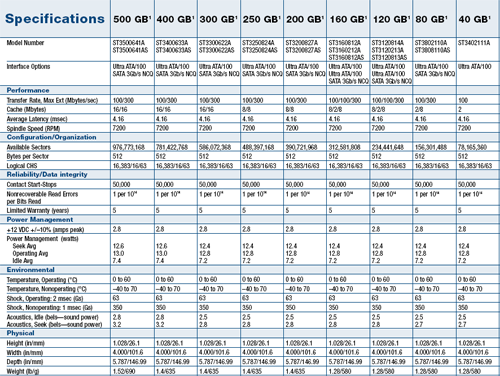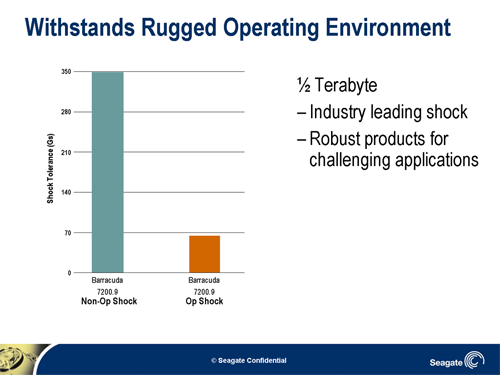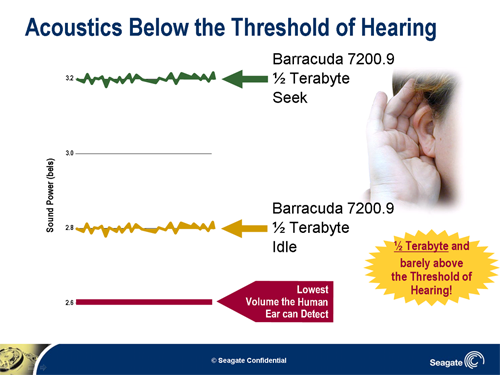Introducing Seagate's 7200.9: The New Generation
by Purav Sanghani on October 10, 2005 9:00 AM EST- Posted in
- Storage
The 7200.9 Series
On the outside, the 7200.9 drives look identical to the 7200.7 and 7200.8 series of desktop drives. On the inside, the 7200.8 line was the first to incorporate the highest density platters to date in their 400GB version drive at 133GB per platter. This puts Seagate ahead of Hitachi who released their 500GB DeskStar quite some time ago. The new 7200.9 line has incorporated a higher density 160GB platter into a few of its drives. The following screenshot shows the manufacturer's specifications for each 7200.9 drive according to capacity size.
The 160GB platter has only gone into the 80GB drive, which uses a single side and single head, and the 160GB drive, which uses both sides of the platter with 2 heads. The 400GB model still uses its original three 133GB platter design that was implemented in the 7200.8, while the new 500GB drive uses four 125GB platters. Why not just use the 160GB platters for the 500GB drive? Doing the math, 3x160GB would bring us to 480GB, which is 20GB short of the 500GB mark, and 4x160GB comes out to 640GB, which cannot be marketed at 500GB without a 140GB waste in total capacity. It makes the most sense to use 4x125GB platters to bring us to a perfect 500GB total capacity. (Note that the drive's total capacity will be slightly lower in Windows, as 1GB is 1,073,741,824 bytes for Windows, but only 1,000,000,000 bytes in hard drive manufacturer specs.)
All of the SATA 2.5 Trimmings
A few months ago, we cleared up some confusion regarding the SATA naming conventions and what they mean. The confusion was with the SATA II name being used in unison with the 3.0Gb/sec transfer rate. SATA II was actually the name of the SATA standards organization, which decides the specifications for each SATA version. (They've since changed names to SATA-IO.) At the time, many thought that the 3.0GB/sec came standard in all drives labeled as SATA II. In fact, transfer rate along with other options such as hot plug, hot swap, and NCQ are options that drive manufacturers can implement in their products if they choose. You can even get most of the "SATA II" features in "SATA I" drives.
Seagate states that it has incorporated all of the features that SATA has to offer in the 7200.9 series including the following:
In 2004, 20% of hard disk drives shipped were SATA based - about 41 million, according to Seagate Market Research. It is estimated that this year, the percentage will increase to 80% of shipped drives being SATA based, 40% of which will be Seagate drives. Meanwhile, PATA is being phased out and nearly all production will cease by the end of 2006.
Other Characteristics
Seagate reports that all of the drives in the 7200.9 line will feature an operating shock tolerance of about 63Gs and a non-operating shock of 350Gs, making them extremely rugged. Almost all but Hitachi's 7K500 drive can handle this much non-operating shock, but shock tolerance during normal operation is not as forgiving, with many drives only allowing about 55Gs. Not that we would recommend dropping your drives or computer, but accidents happen...
Seagate is also reporting a lower sound rating between 2.5-2.8 bels while the drives are idle, and about 2.8-3.2 bels while the drives are seeking for data. According to Seagate, the lowest amount of sound audible by human ears is about 2.6 bels, so the idle noise output is borderline inaudible to our ears. Combine this with the hum of case and heat sink fans, and the hard drive is basically silent.
On the outside, the 7200.9 drives look identical to the 7200.7 and 7200.8 series of desktop drives. On the inside, the 7200.8 line was the first to incorporate the highest density platters to date in their 400GB version drive at 133GB per platter. This puts Seagate ahead of Hitachi who released their 500GB DeskStar quite some time ago. The new 7200.9 line has incorporated a higher density 160GB platter into a few of its drives. The following screenshot shows the manufacturer's specifications for each 7200.9 drive according to capacity size.
The 160GB platter has only gone into the 80GB drive, which uses a single side and single head, and the 160GB drive, which uses both sides of the platter with 2 heads. The 400GB model still uses its original three 133GB platter design that was implemented in the 7200.8, while the new 500GB drive uses four 125GB platters. Why not just use the 160GB platters for the 500GB drive? Doing the math, 3x160GB would bring us to 480GB, which is 20GB short of the 500GB mark, and 4x160GB comes out to 640GB, which cannot be marketed at 500GB without a 140GB waste in total capacity. It makes the most sense to use 4x125GB platters to bring us to a perfect 500GB total capacity. (Note that the drive's total capacity will be slightly lower in Windows, as 1GB is 1,073,741,824 bytes for Windows, but only 1,000,000,000 bytes in hard drive manufacturer specs.)
All of the SATA 2.5 Trimmings
A few months ago, we cleared up some confusion regarding the SATA naming conventions and what they mean. The confusion was with the SATA II name being used in unison with the 3.0Gb/sec transfer rate. SATA II was actually the name of the SATA standards organization, which decides the specifications for each SATA version. (They've since changed names to SATA-IO.) At the time, many thought that the 3.0GB/sec came standard in all drives labeled as SATA II. In fact, transfer rate along with other options such as hot plug, hot swap, and NCQ are options that drive manufacturers can implement in their products if they choose. You can even get most of the "SATA II" features in "SATA I" drives.
Seagate states that it has incorporated all of the features that SATA has to offer in the 7200.9 series including the following:
- Hot Plug
- Hot Swap
- ClickConnect
- Native Command Queuing (NCQ)
- Staggered Spin-Up
- 3G (3.0Gb/sec, backwards compatible with 1.5Gb/sec hardware) maximum transfer rates
In 2004, 20% of hard disk drives shipped were SATA based - about 41 million, according to Seagate Market Research. It is estimated that this year, the percentage will increase to 80% of shipped drives being SATA based, 40% of which will be Seagate drives. Meanwhile, PATA is being phased out and nearly all production will cease by the end of 2006.
Other Characteristics
Seagate reports that all of the drives in the 7200.9 line will feature an operating shock tolerance of about 63Gs and a non-operating shock of 350Gs, making them extremely rugged. Almost all but Hitachi's 7K500 drive can handle this much non-operating shock, but shock tolerance during normal operation is not as forgiving, with many drives only allowing about 55Gs. Not that we would recommend dropping your drives or computer, but accidents happen...
Seagate is also reporting a lower sound rating between 2.5-2.8 bels while the drives are idle, and about 2.8-3.2 bels while the drives are seeking for data. According to Seagate, the lowest amount of sound audible by human ears is about 2.6 bels, so the idle noise output is borderline inaudible to our ears. Combine this with the hum of case and heat sink fans, and the hard drive is basically silent.
In the next few weeks we will be looking at the performance of the 500GB 16MB SATA model of the 7200.9. We'll put it through our usual synthetic, simulated, and real world tests, and we'll compare it not only to the 400GB 7200.8, but also to some older drives like the 120GB 7200.7 as well as Maxtor's and Hitachi's higher capacity drives.













72 Comments
View All Comments
ksherman - Monday, October 10, 2005 - link
and i just bought a 400GB Seagate... oh well.Live - Monday, October 10, 2005 - link
The sound info from Seagate is so obvious bull. And also the comments regretfully often found here @ AT:A sound being drowned out does not make it silent. And assuming that everybody uses 8 delta case fans at full speed and thus does not care about the sound from hard drives, PSUs and graphic cards is just plain stupid in my opinion. With today’s water cooling and heat pipe technologies a lot of people are turning to the silent side. A hard drive in my system is one of the noisiest components.
Don’t know what I am commenting tough, I thought I clicked an article but it turned out to be nothing more then an advert. Leave this kind of info for the news section and be an independent hardware site that you usually do so well.
segagenesis - Monday, October 10, 2005 - link
Well thats somewhat obvious, and my experience with Seagate dictates they havent been as quiet as the old Barracuda IV was. Those drives *were* basically silent, you could almost never hear them... even if they were under load.andyc - Monday, October 10, 2005 - link
How would the Seagate's new line compare with the Western Digital's:"Western Digital Caviar RE2 400GB 7200RPM SATA 16MB 8.7"
"Western Digital Caviar SE16 400GB 7200RPM SATA 16MB 8.9MS"
"Western Digital Caviar SE16 250GB 7200RPM SATA2 16MB 8.9MS"
I've had nothing but good experiences with Western Digital...but I might turn over to Seagate if they turn out to be more superb.
coldpower27 - Monday, October 10, 2005 - link
The Seagate line I think matches the Western Digital line very well.
It has less platters at 400GB capacity, 3x133 Design vs WD 4x100 design and less platters at 250GB 2x125 vs WD 3x83. Seagate has SATA2 from 80GB-500GB, where WD is limited to 120GB to 250GB for their SATA2 drives, only downfall is that to get the 16MB buffer is only available at 300GB & higher for Seagate, where WD has a single model SATA2 drive with 16MB Buffer the 250GB model, the other 120GB to 250GB drives are like Seagate limited to 8MB buffer. Seagates 80GB to 250GB for 8MB is competitive. Plus seektime is 8.5ms. Plus for Seagate their drives get a 5 Year Warranty, not like WD which only get 5 Years on it's RE and Raptors lines I believe and 3 Years on the rest.
coldpower27 - Monday, October 10, 2005 - link
Is the Seagate 7200.9 16MB 300GB 3x100 or 2x150 with the advent of 160GB Platter technology from Seagate.
tomoyo - Monday, October 10, 2005 - link
If you look at the table of specs, you'll notice the 300GB has the same wattage as the smaller models including the 1 platter(12.4/12.8/7.2 watts). Also it's got the same acoustics as the smaller models of 2.5 idle and 2.8 seek. The larger 400/500 models have slightly higher wattage and 2.8 idle/3.2 seek. This leads me to strongly believe that the 300GB model is also a 2 platter design using 150GB a platter...and is therefore slightly short stroked on a 160GB platter. I hope I'm proven right, because assuming it's a reasonably quiet drive...it's definitely the one I WANT! Looks like a candidate for the best drive with the features of quiet, a decent amount of storage, SATA 2.5 and a 5 year warranty!coldpower27 - Tuesday, October 11, 2005 - link
Yeah I hope so to, I am so far fond of the 2 platter design drives. I don't really want to a larger number of platters if unecessary.JarredWalton - Monday, October 10, 2005 - link
I believe it's 3x100GB. It might also be 3x133, but only using five heads (i.e. 2.5 platters). Actually, 5 heads seems more likely, but I don't know for sure.There are a few specific platter sizes that are common. Right now, those are (as far as I know):
60GB (old and on the way out, if not gone already)
80GB (fading fast)
100GB (still in production, but diminishing over time)
120/125GB (Relatively new; different brands might go one way or the other)
133GB (only a slight bump from 120/125, really - still new. Some "failed" platters might be formatted for 120/125GB)
160GB (brand new starting with certain Seagate 7200.9)
There is variance to a degree within those sizes. I think some of the 250GB drives, for example, use 133GB platters that are downgraded to 125GB capacity.
semo - Monday, October 10, 2005 - link
why don't some hdd maker sticks 2-3gb of flash memory to a 200gb something hdd.i don't even have to list the possibilities of such a solution, do i?